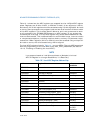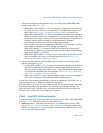
10-14 Vol. 3
ADVANCED PROGRAMMABLE INTERRUPT CONTROLLER (APIC)
x2APIC will introduce 32-bit ID; see Section 10.5.
10.4.7.1 Local APIC State After Power-Up or Reset
Following a power-up or RESET of the processor, the state of local APIC and its regis-
ters are as follows:
• The following registers are reset to all 0s:
• IRR, ISR, TMR, ICR, LDR, and TPR
• Timer initial count and timer current count registers
• Divide configuration register
• The DFR register is reset to all 1s.
• The LVT register is reset to 0s except for the mask bits; these are set to 1s.
• The local APIC version register is not affected.
• The local APIC ID register is set to a unique APIC ID. (Pentium and P6 family
processors only). The Arb ID register is set to the value in the APIC ID register.
• The spurious-interrupt vector register is initialized to 000000FFH. By setting bit 8
to 0, software disables the local APIC.
• If the processor is the only processor in the system or it is the BSP in an MP
system (see
Section 8.4.1, “BSP and AP Processors”); the local APIC will respond
normally to INIT and NMI messages, to INIT# signals and to STPCLK# signals. If
the processor is in an MP system and has been designated as an AP; the local
APIC will respond the same as for the BSP. In addition, it will respond to SIPI
messages. For P6 family processors only, an AP will not respond to a STPCLK#
signal.
10.4.7.2 Local APIC State After It Has Been Software Disabled
When the APIC software enable/disable flag in the spurious interrupt vector register
has been explicitly cleared (as opposed to being cleared during a power up or
RESET), the local APIC is temporarily disabled (see Section 10.4.3, “Enabling or
Disabling the Local APIC”). The operation and response of a local APIC while in this
software-disabled state is as follows:
• The local APIC will respond normally to INIT, NMI, SMI, and SIPI messages.
• Pending interrupts in the IRR and ISR registers are held and require masking or
handling by the CPU.
• The local APIC can still issue IPIs. It is software’s responsibility to avoid issuing
IPIs through the IPI mechanism and the ICR register if sending interrupts
through this mechanism is not desired.
• The reception or transmission of any IPIs that are in progress when the local APIC
is disabled are completed before the local APIC enters the software-disabled
state.


















